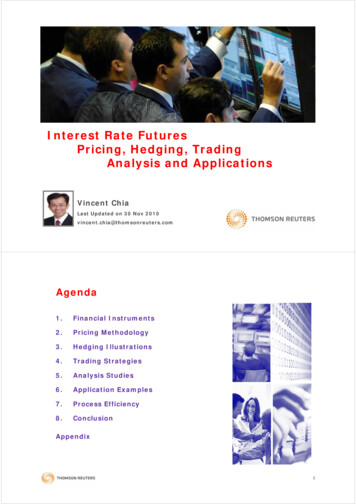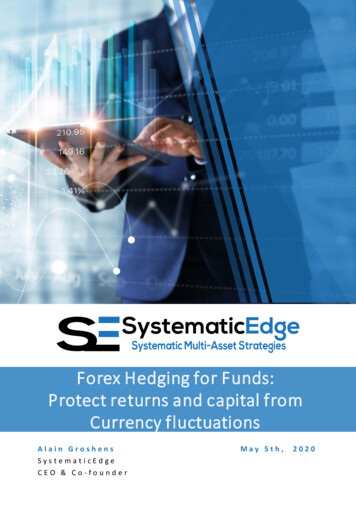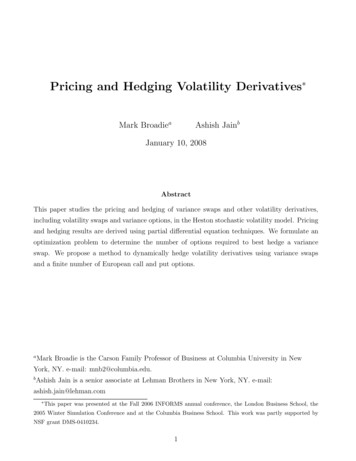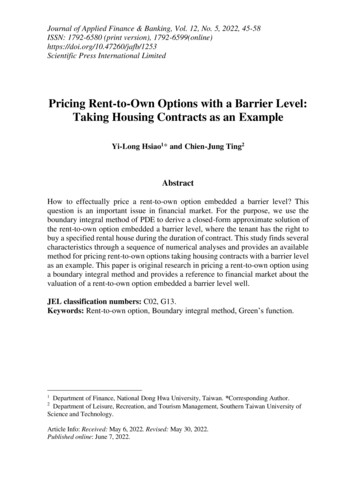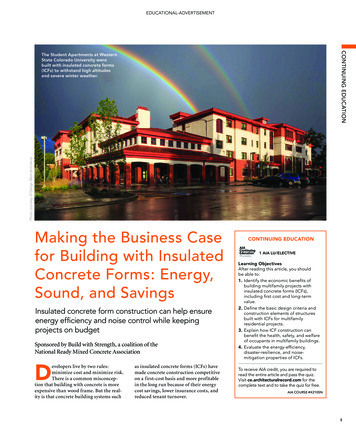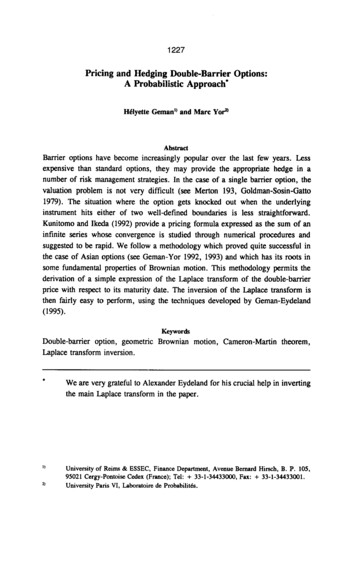
Transcription
1227Pricing and Hedging Double-Barrier Options:A Probabilistic Approach'Hklyette Geman') and Marc Yor"AbstractBarrier options have become increasingly popular over the last few years. Lessexpensive than standard options, they may provide the appropriate hedge in anumber of risk management strategies. In the case of a single barrier option, thevaluation problem is not very difficult (see Merton 193, Goldman-Sosin-Gatto1979). The situation where the option gets knocked out when the underlyinginstrument hits either of two well-defined boundaries is less straightforward.Kunitomo and Ikeda (1992) provide a pricing formula expressed as the sum of aninfinite series whose convergence is studied through numerical procedures andsuggested to be rapid. We follow a methodology which proved quite successful inthe case of Asian options (see Geman-Yor 1992, 1993) and which has its roots insome fundamental properties of Brownian motion. This methodology permits thederivation of a simple expression of the Laplace transform of the double-barrierprice with respect to its maturity date. The inversion of the Laplace transform isthen fairly easy to perform, using the techniques developed by Geman-Eydeland(1995).KeywordsDouble-barrier option, geometric Brownian motion, Cameron-Martin theorem,Laplace transform inversion.We are very grateful to Alexander Eydeland for his crucial help in invertingthe main Laplace transform in the paper.')University of Reims & ESSEC, Finance Department, Avenue Bernard Hirsch, B. P. 105,95021 Cergy-Pontoise Cedex (France); Tel: 33-1-34433000, Fax: 33-1-34433001.University Pans VI, Labratoire de Probabilitk. *)
12281. INTRODUCTIONBarrier options have become increasingly popular over the last few years.Less expensive than the equivalent standard options, they may be theappropriate hedge in a number of situations. For instance, a down-and-input with a low barrier offers an inexpensive protection against a bigdownward move of the underlying asset ; in the same manner, an up-andout call on an index may enhance at a cheap cost an already existing longposition in the index.The pricing of "single barrier" options is not difficult in the standard Blackand Scholes framework. An arbitrage approach leads to a fairly elementarymathematical problem and closed-form solutions have been available forsome time. For instance, in his seminal paper of 1973, Merton presented apricing formula for an option whose pay-off is restricted by a floor knock-outboundary ;in 1979, Goldman, Sosin and Gatto offered closed-form solutionsfor all types of barrier options. The problem of double-barrier options whichwe address in this article is more difficult and, to our knowledge, no simpleformula currently exists. Consequently, practitioners who trade theseinstruments rely heavily on the use of simulations to obtain option prices.Simulation is indeed an effective and simple tool readily that is applicable tothe problem of valuing some of the most complex contracts. However, Fu,Madan and Wang (1995) show that for continuous time Asian options, andsuspect that for other continuous time path-dependent options as well,naive simulations based on pricing strategies are expensive, inefficient andinaccurate. They even find that decreasing the standard error with morereplications only serves to increase the confidence in the wrong valuation.Lastly, Geman and Eydeland (1995) show the remarkable superiority of anexact approach over Monte-Carlo simulations when delta hedging of Asianoptions is at stake.Our goal is to adopt the same type of "exact"pricing methodology in the caseof double-barrier options as the one we followed for Asian options. We usethe standard risk-neutral valuation techniques and the Markov property aswell as the Cameron-Martin theorem to obtain a simple expression of theLaplace transform of the option price. As it is the case for the double-barrieroptions traded in the markets, we will only consider the situation of fixedboundaries.
12292. PRICING DOUBLE-BARRIER OPTIONSA double-knock option is characterized by two barriers L (lower barrier) andU (upper barrier) ; the option knocks out if either barrier is touched.Otherwise, the option gives at maturity T the standard Black and Scholespay-off max(O,S(T)-k), where k, the strike price of the option, satisfiesL k U.The distribution of the range of Brownian motion was studied as early as1941 by Bachelier while the trivariate joint distribution of1(I, inJW,,L, supW,,W, has been known for some time (see e.g.us,Freedman (1971) or Revuz-Yor (1994, p.106)) and is expressed asP(a 5 I, 5 L, 5 b; W, E dx)1 ' (27ct)Tk -{exp(-1(x 2k(b - a))z)-exp( -12t ((x- 2b) 2k(b - a))l)}dx2tThis result and variants of it are found in many places in the probabilisticliterature (see e.g., Doob (1949), Feller (1970), Shorack-Wellner (1986),Teunen-Goovaerts (1994)). It is this path which is followed by Kunitomoand Ikeda (1992) who propose pricing formulas expressed as theta functiontype series for European options whose pay-off is restricted by general curveboundaries.In our setting, the uncertainty in the economy is represented by a filteredprobability space (a, , t, P), where f t is the information available attime t and P is the objective probability. From the seminal papers byHarrison-Kreps (1979) and Harrison-Pliska (1981) we know that the noarbitrage assumption implies the existence of a probability measure Qequivalent to P such that the discounted prices of the basic securities are Qmartingales. Under the probability Q, the dynamics of the price S(t) of theunderlying asset are driven by the stochastic differential equation9 ydt cs dWt,s*
1230where (W(t)) is a Q-Brownian motion, o is constant, and the risk-neutraldrift is assumed to be a general constant. So, we can incorporate the casewhere the underlying instrument is a dividend-paying stock, a currency or acommodity. Equation (1) immediately givesThe call price is equal towhere & uis the first exit time of the process (S,)t,o out of the interval [L,U].We can write for all u 2 t 2 0S(u) S(t)S,(u- t),{[where Sl(s) exp y--3 1s oW(s)and (W(s) W(t s)-W(t),s?O) is anew Brownian motion under Q. Denoting by &B the first exit time of theprocess (SI(s))120out of the interval [a,PI, we obtain the immediate equalityConsequently, if the double-barrier call has not been knocked out prior totime t, its price at time t is equal to
1231kLwhere r T - t , h -,m S(t)S(t)We now observe that, rather than computing the expectation in (3) itis easier to compute the quantityThis will give, by difference with the Black and Scholes formula and anappropriate adjustment, the double-knock call price aswhere BS(O,l,o,h,r) denotes the price at time 0 of a standard call withmaturity r and strike price h written on an underlying stock which hasvalue 1 at time 0 and volatility Q.The quantity (p;jM(r) has a fairly simple expression when 'F is replaced by anexponential variable independent of S1 (the reader interested in thisquestion can find in Appendix 2 a general discussion of the issue : why is iteasier to handle a functional of a Brownian motion W at an independentexponential time rather than at a fixed time ?). This leads us to consider inthis specific case the following Laplace transform with respect to time :Making the change of variables u oo2, the right-hand side of (5) becomeswhere, denoting y - -o22and
1232Recalling the definition ofim,,, inf(s:exp(ow(s) 0s) m or M},we can write equivalentlya) { ( -(3 t , , i x:expnfOW -} m o r where (W(x))was introduced earlier.We defineV TOG(y--):and introducewhere Cg!,represents the first time m or M is reached by the processX:) 3 exp(W(t) vt). Hence,andwhere the function CP is defined as the Laplace transform of q, i.e.,From now on, we will focus on the computation of CP(0). Let us denote forsimplicity f(x) (x-h) and I; ,!:;Iand introduce the positive numbers a
1233and b such that m e-a, M eb. By using the strong Markov property, wesimplify the expression of O(0)@(e) E[e-erE,:.i(lore-"f(X1"))du] E[e-ez(Vlv'f)(Xg')],(7)whereV:')f(x) E:[lre-euf(Xu)du]and El is the expectation relative to Pxv,where P,' is the law of the process(X:),u10) originating in x. To avoid confusion between Brownian andgeometric Brownian motions, we use E, for the expectation with respect tothe Wiener measure of Brownian motion starting at z.ez,Denoting g V ")f, and using the Cameron-Martin absolute continuityrelationship between (Wt vt,t 10) and (Wt,t 2 0), we obtainv2 -,it is straightforward to show (see e.g., ItB-Mc Kean22(1965) or Revuz-Yor (1994)) thatIntroducing andThis is classically obtained by applying Doob's optional sampling theoremto exponential martingales of Brownian motion at T-a andThen, usingthe strong Markov property (see ItB-Mc Kean for details), equation (6)becomesa.
1234We need now to make explicit g(e’) Vlf(ea)defa,(g e-”f(ewu ””)du).Using again the Cameron-Martin relationship, we obtainwhere q,(y) esf(eY) and f(x) (x-h)’.(9)The resolvent of Brownian motion (see e.g., Revuz-Yor, p. 93) is given for ageneral function 9 byIn the case of the specific function q, defined in (9), formula (10) givesFor notational simplicity, we introduce U C , ( Z ) .gl(ez)ievag(ea)Relation (8) becomes(1l.a)where gl(e-a)and gl(eb)are shown, in Appendix 1, to be respectively equalto
1235(1l.b)and(1l.C)We recall that Cg depends on 8 through p JGand that ( h ) ,the quantity of interest, is related to Cg by the formulaUsing this formula and denoting P - 1 for the inverse of the Laplacetransform operator, it is immediate to see that{P-1W}(z) {P-'Cg}(o'z)a result which may be substituted into equation (4) to give the price at time tof the double-barrier call, namelywhere BS(O,l,o,z,h) is the Black and Scholes price of a standard call withkmaturity z T-t, strike price h -, assumed to be written on an underlyingS(t)asset S such that S(0) 1.3. NUMERICAL APPLICATIONSWe use formula (11) and the methoc--Jgy developec in Geman-Eydeland(1995) in order to compute the price of a double-barrier option in threedifferent settings ; in all cases, we compare our results with the pricesobtained through Monte-Carlo simulations and with the prices given inKunitomo and Ikeda (1992).
1236In the three tests, we use the values S(0) 2, T 1yearQ 0.2Qr 0.02Ik 2. L 1.5.U 2.5 0.5r 0.05I k 2, L 1.5,U 3Q 0.5r 0.05k 1.75, L l,U 3021790.276460.23838 st. dev 0.003)The standard deviation is computed on a sample of 200 evaluations, eachevaluation being performed on 5000 Monte-Carlo paths.It is remarkable that in all cases, the price obtained through our method isextremely close to the Kunitomo-Ikeda price. Moreover, in order for thesetwo prices to lie within one standard deviation of the Monte-Carlo price, theMonte-Carlo simulations must be run using very small step sizes and manypaths to make sure one barrier is not "hit but missed". The consequence isthat the inversion of the Laplace transform requires an order of magnitudeless operations than the Monte-Carlo simulations (e.g., it takes a fraction of asecond to do it on a Sun Sparc 20 station). As a comparison, in the case ofAsian options, Geman-Eydeland (1995) obtain a standard deviation as low as0.001 for a sample of 50 evaluations, each of them being performed on 500Monte-Carlo paths (and it is in the context of delta hedging that theinversion of the Laplace transform of the Asian option obtained in GemanYor (1993) proves definitely superior, both theoretically andcomputationally). Using Monte-Carlo methods, one faces a drastic changebetween the smoothing effect of the averaging feature of Asian options andthe danger of hitting a barrier without knowing it in the case of double-
1237knock options. It is not clear that all users of double-barrier options are fullyaware of this problem.A final manner to illustrate this point is to show that, as expected, thesensitivity of the option price to the step size in Monte-Carlo simulationsbecomes extremely high when the time remaining to maturity is short andthe strike price close to one of the barriers.We come back to the first column of the previous table with the sameparameters except that z T-t 1 month and So 2.4.For a step size equal to 1/365 year, Monte-Carlo gives an option value equalto 0.1930 with a standard deviation 0.073 ; for a step size4x365 year, theMonte-Carlo value becomes 0.1739 and the standard deviation 0.008. Hence,a one day step gives a wrong result (the barrier may have been hit and"missed", and the option is overpriced).Using the Geman-Yor approach, we obtain :BS(O,l,o,z,h) O.l681; e-"(L-'y)(z) 0.23015G.Y price 2.4 x 0.1681-0.23015 0.173214. HEDGING DOUBLE-BARRIER OPTIONSAmong the sensitivities of the option price to the different variables, thesensitivity to the underlying asset price is the first subject of concern forpractitioners.In order to compute the delta of the double-barrier option, we differentiatewith respect to S(t) the expression of C,,,(t) established in formula (12) andobtain-(t) - [BS(O,l, 0 ,2,h) - e-n{L-' /}(T)]- S(t)e-"as(t)L.Ua {L-'w}( z)as(t)(13)The quantity between brackets equals the call price divided by S(t). We nowneed to find the derivative with respect to S(t) of {P-'y}(z).
1238To clearly exhibit the dependence in S(t) of the function w , we write S(t) x;and we express formula (11) in terms of x. Rememberingthat m e-’ and M eb,we obtainmPhV l-Pgl(m) p(w - v)(p - v - 1)andkLULastly, we need to write that h -,m -,M -, which givesXwhere a(L,U,k) XXL2pkv l-P1u2l’- L2l’ p(p - v)(p - v - 1)’
1239We are consequently led to a problem of Laplace inversion nearly identicalto the one encountered for the call price and involving a @ x instead of ax,axwhere
1240CONCLUSIONFrom these results, we can easily derive the prices of double knock inoptions, i.e., options which pay like a vanilla call if the underlying spot pricetouches a lower or higher barrier prior to expiration but pay nothing (or afixed rebate) if neither barrier is hit prior to expiration. In the same manner,double-barrier digital options, which pay a fixed amount if some referenceasset price has remained within a band over the lifetime of the option, maybe obtained as a special case of the valuation problem addressed in thispaper. As in Geman-Yor (1993), this approach is satisfactory from atheoretical standpoint since the methodology is the same for the call priceand for its delta. For practical purposes, the computational time of the twoquantities is equally low and hedging - the ultimate concern of practitioners- is achieved with the same accuracy as pricing, which is rarely the case forpath-dependent options. Moreover, the danger inherent- in Monte-Carlomethods applied to barrier and double-barrier options disappears in thisapproach.
1241BIBLIOGRAPHYBACHELIER L. (1941) "Probabilitbs des Oscillations Maxima", Note auxComptes Rendus des Siances de Z'Acadhie des SciencesBLACK F. and M. SCHOLES, (1973) "The Pricing of Options and CorporateLiabilities", Journal of Political Economy, 81, 637-654.CHESNEY M., JEANBLANC M. and M. YOR (1995) "Brownian Excursionsand Parisian Barrier Options", To appear in A d v . in Appl. Proba.DOOB J.L. (1949) "Heuristic Approach to the Kolmogorov-SmirnovTheorems" Annals of Mathematics Statistics 20, 393-403FELLER W. (1970) "Introduction to Probability Theory and its Applications",Vol 2, 2nd edition, WileyFREEDMAN D. (1971) "Brownian Motion and Diffusion", Holden-DayFU M., D. MADAN and T. WANG (1995) "Pricing Continuous Time AsianOptions : A Comparison of Analytical and Monte Carlo Methods", Preprint,University of MarylandGEMAN H. and A. EYDELAND (1995) "Domino Effect : Inverting theLaplace Transform", RISK, AprilGEMAN H. and M. YOR, (1992) "Quelques relations entre processus deBessel, Options Asiatiques et Fonctions Confluentes HypergComktriques",Notes aux Comptes Rendus de Z'Academie des Sciences , Skr. I., 471-474GEMAN H. and M. YOR, (1993) "Bessel Processes, Asian Options andPerpetuities", Mathematical Finance, 3, N"4, 349-375GOLDMAN, M., H. SOSIN and M. GATT0 (1979) "Path Dependent Options :Buy at the Low, Sell at the High', Journal of Finance, 34, 111-127HARRISON J.M. and D. KREPS (1979) "Martingales and Arbitrage inMultiperiod Securities Markets", Journal of Economic Theory 20, 381-408HARRISON J.M. and S. R. PLISKA (1981) "Martingales and StochasticIntegrals in the Theory of Continuous Trading", Stoch. Proc. Appl, 11, 215260
1242KUNITOMO N. and M. IKEDA (1992) "Pricing Options with CurvedBoundaries", Mathematical Finance, Vol. 2, N"4, 275-2I T 0 K. and H.P. Mc KEAN (1965) "Diffusion Processes and Their SamplePaths", SpringerMERTON R.C. (1973) "Theory of Rational Option Pricing", Bell. J. Econ.Manag. Sci., Vol4, p. 141-183R E W Z D. and M. YOR (1994) "Continuous Martingales and BrownianMotion", 2nd edition, SpringerSHORACK G.R. and J.A. WELLNER (1986) "Empirical Processes withApplications to Statistics", WileyTEUNEN M. and GOOVAERTS M. (1994) "Double Boundary CrossingResult for the Brownian Motion", Scand. Act. J. ,Vol 2
1243APPENDIX 1Computation of Ul'cp(z)4 5 ,We recall that p hence p v. Ye are looking for a simpexpression of U.'cp(z). We know thatUc.'p(.) -Ienh1 -e-Plz-Yl [e- heg]dy H;(Pnh,v l)-hH:(Pnh,v),def(V l)YPwhere2 nthe case of gl(e-") i Ulcp(-a), the integrals2do not need to be split since z -a is smaller than lnh and one easilyobtainsFor the computation of g,(eb) Ucq(b), both integralsjtz e-pla-yl mydy(m v and v 1) have to be split since z b is bigger than lnh ; this leads tothe following expression :
1244APPENDIX 2Why are the laws of functionals of X, oW, vt (Brownian motion withconstant volatility o O and drift v) such asMt supxuor I, -inf XusimplerUStUS,when the fixed time t is replaced by an exponential time 7 independent ofW ? A first explanation stems from the lack of memory of the exponentialvariable ; but a deeper answer may be given in terms of excursion theory,which implies for instance that M, - X, and M, are independent. Thisproperty is also well-known to be a consequence of the Wiener-Hopffactorization, which is referred to by Rogers and Satchell (1991) whenlooking at high, low and closing stock prices. However, Rogers and Satchellobserved in their paper that cross-moments such as E[M,I,(M, I,)(X, I,)]are hard to compute in the case of a nonzero drift v. We show below thatthe distribution of the triple (X,,M,,I,) - a quantity of great interestthroughout our paper - has a fairly simple expression ; its use may inparticular allow to compute, at the cost of a multiple integral, the abovementioned expectation.Let us denote7, ane2exponential time independent of X, with parameter -.2Then, we have the formulawhere p 2cp(a,b,x) (V x 2 )and{cothx - cotha, if 0 x asinh(lx1)cotha cothb cothlxl-cothb, if - b x OProof1. The formula in the "reduced case" 8 1, o l,v O is found in Pitman-Yor(1992) and has been obtained using excursion theory.2. We now show how to obtain the general formula, using essentially theCameron-Martin relation between Brownian motions with zero andnonzero drift, and the scaling property of Brownian motion.
1245(2i) We first show the formula in the case o lWe denote W/”) W, vt, MI’) sup WJ’), I?) -infW:’)sstsstWe have, for any measurable f : R x R x R - Rlaw 1Thanks to the scaling with respect to z, i.e., z, T z l ,Pwe obtainWe now use the Pitman-Yor result in the “reduced case” and (1) in order toderive -Idxtp(ap,bp,x)fe2PZwhich gives the result in the case CJ 1.(2ii) To get the general formula, we write(3oW, vt o wt -t
1246We denote M(,),I(l),W(l)the random quantities in (1) where v is replacedby:wherewrefers to the density function obtained in (2) but with v replacedVby 0'Hence our final quantity isREFERENCESPIT".J and M. YOR (1992) : "The I 's of Horn gene us Functionals ofBrownian Motion and Related Processes", Reprint, University of BerkeleyROGERS L.C.G. and S.E. SATCHELL (1991) "Estimating Variance from High,Low and Closing Prices", Annals of Applied Probability, Vol l., N"4, 504-512
1229 2. PRICING DOUBLE-BARRIER OPTIONS A double-knock option is characterized by two barriers L (lower barrier) and U (upper barrier) ; the option knocks out if either barrier is touched. Otherwise, the option gives at maturity T the standard Black and Scholes pay-off max(O,S(T)-k), where k, the strike price of the option, satisfies


